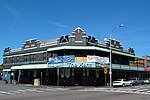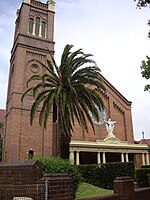Hamilton railway station, New South Wales
Easy Access railway stations in New South WalesNew South Wales State Heritage RegisterRailway stations in Australia opened in 1872Railway stations in the Hunter RegionRegional railway stations in New South Wales ... and 2 more
Short-platform railway stations in New South Wales, 6 carsUse Australian English from June 2020

Hamilton railway station is a heritage-listed railway station on the Newcastle line in the inner Newcastle suburb of Hamilton in New South Wales, Australia. It was added to the New South Wales State Heritage Register on 2 April 1999.On 5 January 2015, Hamilton became the interim terminus for NSW TrainLink's Central Coast & Newcastle and Hunter line services following the partial closure of the Newcastle line. It fulfilled this role until Newcastle Interchange opened on 15 October 2017.
Excerpt from the Wikipedia article Hamilton railway station, New South Wales (License: CC BY-SA 3.0, Authors, Images).Hamilton railway station, New South Wales
Eva Street, Newcastle-Maitland Hamilton
Geographical coordinates (GPS) Address Nearby Places Show on map
Geographical coordinates (GPS)
| Latitude | Longitude |
|---|---|
| N -32.918494 ° | E 151.748555 ° |
Address
Platform 1
Eva Street
2303 Newcastle-Maitland, Hamilton
New South Wales, Australia
Open on Google Maps






